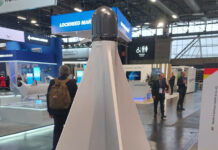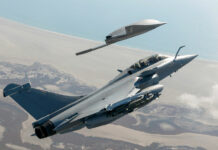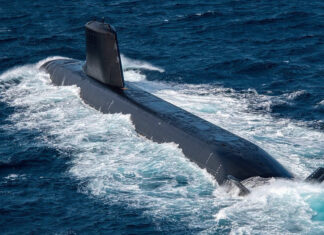Updated: The Indian Navy conducted the first firing test of an MRSAM naval air defense missile employed in the full Joint Taskforce Coordination (JTC) mode. JTC implements the MRSAM ‘Cooperative Engagement’ operating mode which sets the system apart from other air defense systems. The recent trial comprised two complex scenarios involving multiple platforms and several simultaneous targets.
On the recent test, conducted on 15 May at India’s western seaboard, two destroyers, INS Kochi and INS Chennai detected multiple targets using their MF-STAR radars and launched several missiles at those targets. What was different was that only one of the ships controlled the engagement, intercepting different aerial targets at extended ranges by the missiles fired from both ships using the systems’ JTC mode. The test demonstrated the ability of MRSAM to operate wide-area air defense, distributing assets and control over different platforms and locations. Previous MRSAM firing trials were conducted on a single platform, in the stand-alone mode.
The new engagement capability derives from the network-centric architecture of the Barak 8 system and its MF-STAR 360º radar system that harness multiple sensors, launch platforms, and effectors into a single air defense system. By fitting a data link to each interceptor, missiles can be updated via data-link after launch by any network member. With this capability, Barak-8 missiles can receive target updates on their mid-course, with updated target information, retasking the highest priority target, until the missile enters the terminal engagement. This capability maximizes missile utilization and battle economy. It enables a single ship to orchestrate the air defense mission or allocate missions to other vessels when required.
Barak 8 (MRSAM) features a dual pulse rocket motor as well as Thrust Vector Control, and possesses high degrees of maneuverability at target interception range. A second motor is fired during the terminal phase, at which stage the active radar seeker is activated to home in on to the enemy track. Barak 8 has been designed to counter a wide variety of airborne threats, such as; anti-ship missiles, aircraft, UAVs drones, and supersonic missiles. The missile has a maximum speed of Mach 3 (3,700 km/h_ with a maximum operational range of 38 nm (70 km), which was later increased to 80 nm (150 km) with the introduction of Barak 8 ER.
MRSAM Surface to Air Missiles (also known as Barak 8) are fitted onboard the Kolkata Class Destroyers (Kolkata, Cochi, and Chennai) and would also be fitted on all future major warships of the Indian Navy. The test was carried out by the Indian Navy, DRDO, and Israel Aerospace Industries. Bharat Electronics (BEL) is the prime contractor for the Indian MRSAM system.
Cooperative engagement involves using data links between ships and platforms to have a “common picture” of a battle situation and taking control of weaponry on multiple platforms. In addition to the target hard-kill, such capability also improves the battlegroup’s resilience against jamming.




















